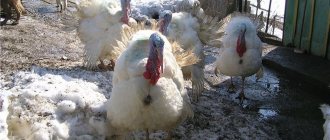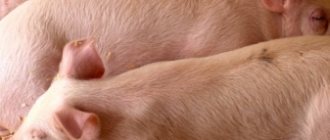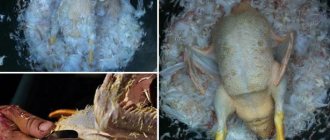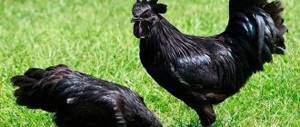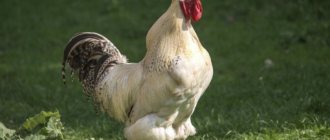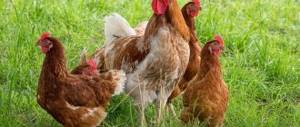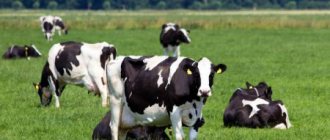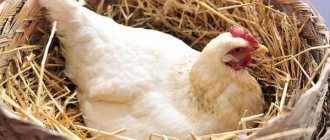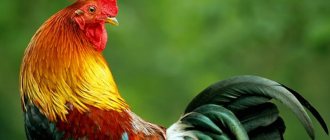Any poultry can fly, although for centuries people have been trying to wean it from flying. Long-distance flights are beyond the capabilities of a domestic chicken, duck or turkey, but they are capable of overcoming a fairly high fence. Such flights can only lead to troubles with neighbors and destroyed crops in the garden. Possible injuries when overcoming fences, attacks on birds by dogs, or their death under the wheels of passing vehicles. Various infectious diseases acquired outside the fenced area or the consumption of low-quality random food by feathered pets cannot be ruled out.
A chicken is quite capable of climbing a fence up to 3 meters high. Usually such flights occur when the bird is frightened by something. Sometimes flights are associated with a lack of water or food in the pen, especially grass, which the chicken sees behind the fence.
Once a chicken flies over the fence once, it will do this constantly. Chickens should have their wings clipped to prevent them from flying.
The procedure is performed in the following order:
- catch a chicken
- press tightly to yourself,
- spread your wing
- trim the flight feathers by five to six centimeters with scissors.
It is enough, and even better, to clip only one wing, then the chicken’s attempt to fly will end in failure due to loss of balance in flight. The procedure is painless for the bird, but trimming will have to be done twice a year as the trimmed feathers grow back.
The most difficult part of the wing trimming operation is catching the chicken. And when their number is quite large, the task of catching chickens becomes very difficult.
It is recommended to perform pruning in the dark..
By turning off the light in the chicken coop and illuminating it only with a low-power flashlight, you can safely take in chickens that are blind in the dark. By taking them out into the light one by one, trimming their wings and releasing the trimmed ones into a separate pen, you can get the job done quite quickly and without any problems for yourself and without stress for the bird.
You should not trim the feathers of hens hatching chicks. When incubating eggs, the wings serve as a tool for turning them over in the nest. When the chicks hatch and live, warmed and hidden under the mother, the wings act as a temperature regulator and protect the offspring.
The turkey only outwardly looks like a sedate and leisurely bird. In fact, it can easily overcome the high fence of the aviary and fly at a speed of about 25 kilometers per hour, despite the very decent weight of an adult bird, reaching 35 kg.
It’s easy to trim a turkey’s wings, but it’s difficult for one person to handle an adult bird; an assistant is needed. It is enough to trim the flight feathers of the wing or tail by ten centimeters so that the bird stops flying until they grow back again. Turkey feathers are sometimes trimmed three times a year.
There are other ways to limit the flight of turkeys: cauterizing the wings of turkey poults at one day of age and tying the wings, but it would be correct to invite a specialist for these procedures. Of all the turkey breeds, only the white broad-breasted ones are incapable of flight.
Tomato Volgograd: characteristics and description of the variety
Long-term selection of domestic ducks has led to their almost complete loss of the habit of flying. But certain breeds that are closer to their wild relatives than others, including Indian ducks, can fly quite high and are able to overcome a three-meter fence. Their ability to fly often manifests itself during sudden fright.
To prevent the duck from flying away, its flight feathers, designed to lift the bird into the air, are shortened. They are the largest and difficult to confuse with others. Pruning should be done with sharp scissors; about eight centimeters should be trimmed.
Domestic geese are also capable of flying, although not very high. Trimming their feathers is done in the same way as domestic ducks, but a goose is larger and heavier than a duck, so it is better to do the trimming work with an assistant.
It is very important to trim the feathers on only one wing. If both wings are clipped, the duck and goose will still fly. Pruning is carried out after the end of molting. Ducks should not have their wings trimmed before they are 15 weeks old.
At what age should turkeys' wings be clipped?
To learn how to properly keep turkeys, you need to learn the peculiarities of their feeding, reproduction, placement, as well as the behavioral characteristics of individuals. However, in addition to these key factors, farmers are often faced with the issue of trimming bird feathers. First of all, this is due to the fact that turkeys can fly well, so trimming their wings is a necessary measure.
You can trim the plumage of turkeys at any age; in this case there are no restrictions. If necessary, the farmer can clip the wings of both adult turkeys and turkey poults over one month old. Unfortunately, there is currently no clear definition of the appropriate age for wing clipping or how to trim them. If you wish, you can choose one of the existing options, but it is better to use scissors.
How to properly trim the wings of turkeys?
If your birds are showing aggression and trying to fly away into the wild, you should consider trimming their wings. This procedure can cause a lot of trouble for you and cause panic in the birds. However, if you follow all the rules and regulations, you can avoid unnecessary difficulties. Follow the tips below to perform the feather trimming procedure.
- When trimming feathers, you should ask a partner to help you, as the bird may break free and run away or fly away during the procedure. It is necessary to trim the flight feathers by about half or two-thirds so that the turkeys do not feel pain.
- If aggression is active, you can throw a dark bag over the bird’s head; this will limit the bird’s field of vision and force the turkey to calm down.
- To prevent the bird from fussing, you can pour its favorite food into the feeder; this will distract the turkey and make it easy to catch.
- During the procedure, the assistant must hold the bird tightly between its legs so that it cannot twitch. At this time, you straighten the wing and use scissors or pruning shears to trim the flight feathers. The same manipulation is carried out on the second wing.
- The procedure must be performed very quickly so that the bird does not experience emotional stress.
Procedure for trimming wings
Feather trimming occurs in several stages, so it is important to understand the specifics of this procedure. The principle is this:
- First you need to trim the secondary flight feathers on each wing. This will deprive the bird of the ability to fly, but will preserve its beautiful appearance.
- Observe the turkeys for several days; perhaps trimming the secondary plumage will be enough to limit flight.
- If this does not help, you will have to sacrifice beauty. It is necessary to trim the main feathers on one wing, this will deprive the bird of the ability to fly.
Do turkeys fly or not?
Flying wild turkey
Domestic turkeys are considered the largest domestic birds. Their weight depends on the breed and conditions of detention: on average, the weight of males can reach 13-24 kg, and turkeys - from 7 to 14 kg.
In home-keeping conditions, novice farmers may have a question:
- Do turkeys fly or not?
Unfortunately, domesticated turkeys fly. Despite their heavy weight (there are individuals up to 30 kg), they can reach speeds of up to 25 km/h. Therefore, it is simply impossible to do without specially taken measures to prevent flights.
Wing clip - for birds
You can also have on your property such a breed as broad-breasted white turkeys, which absolutely do not fly.
Of course, most domestic turkey breeds hardly fly, although some can easily overcome high barriers or climb a tree.
White turkey
It’s difficult to call it flight, but, nevertheless, at one fine moment, you may be missing several individuals from your enclosure. Even the constant availability of food and water, a large area of the enclosure and good living conditions will not be able to keep this bird from flying away.
Special methods and techniques for keeping birds in an aviary, which have been repeatedly tested in practice, can come to the aid of the farmer.
This can be done in several ways:
- Build a roof over the entire area of the enclosure.
- Trim the flight feathers on the wings.
- Tangle the turkey wings using tape.
- Burn the wings of day-old turkey poults.
Turkey breeds prone to flight
In the modern classification, there are more than thirty breeds of domestic turkeys of various weights and breeding directions:
- egg;
- meat and eggs;
- meat breeds, so-called broilers.
How to clip turkeys' wings
Several breeds are in greatest demand in Russian households:
- Bronze Broad-chested;
- White Moscow;
- White broad-chested;
- The so-called Bigs, crosses bred by the British with the markings Big-6, Big-8, Big-9.
The largest in the world is considered to be Big number six; turkeys of this cross in adulthood can easily reach 40 kilograms.
And now a logical question arises: can a bird with such a huge weight fly and fly over a fence? It turns out it can, and how! Adult turkeys are capable of flying at speeds of more than 20 kilometers per hour.
Well, of course, they won’t fly south to spend the winter, but this bird is quite capable of flying over a two-meter fence in search of greener and tastier grass, or flying onto a tree branch to feast on fruit. And at the same time dig up and trample the beds in the owner’s or neighbor’s garden.
All other breeds will require the owners to answer the question - what to do to prevent turkeys from flying? And taking urgent measures to restrict the freedom of poultry, in order to avoid conflicts with neighbors and the safety of the birds themselves. Otherwise, having left the territory allotted to it, the turkey may well die under the wheels of a car or be torn apart by dogs.
Flying turkey
Why is turkey good?
The turkey breeding business is profitable. A turkey eats three times more feed than a chicken, but also grows faster. In eight months, his weight can reach 25 kg!
And the question of whether turkeys fly will quickly disappear. Everything will be clear when the first chicks grow up.
Do turkeys fly if they are well fed? Unfortunately yes. A huge bird weighing more than thirty kilograms can reach speeds of up to 25 km/h. Therefore, it is impossible to do without the above methods of preventing flights. Unless you have broad-breasted white turkeys on your farm. Turkeys of this breed cannot fly at all.
Contagious diseases
Conventionally, diseases are divided into contagious and non-contagious. The first ones are considered the most dangerous, since they are instantly transmitted in the herd, affecting the entire livestock. When at an early stage the poultry farmer is able to determine what turkeys may be sick with, the symptoms and treatment, the chance of salvation increases even in severe cases.
Sinusitis
Sinus disease is accompanied by an inflammatory process and is more often observed in young animals. The virus is transmitted through the air, food, and contaminated drinking bowls and feeders. It is easy to cure sinusitis, but inaction will lead to the death of the livestock.
The main symptoms can be easily identified by liquid discharge from the nostrils and eyes, the formation of swollen eyelids, and hard crusts. The bird has difficulty breathing and wheezing is heard in its voice.
Antibiotics and immunity-boosting drugs are used for treatment. Add 1 tsp to 1 liter of water. "Farmazin 500", soldered for 5 days. If there are no changes, the course is extended or Tylan is used. The antibiotic is dissolved in 0.5 g/1 liter of water, and the turkey’s nose and eyes are additionally washed to remove mucus and crust. Along with the treatment, all livestock are given the Chiktonik vitamin complex for 5 days, dissolving 1 ml of the drug per 1 liter of water.
Histomoniasis
Histomoniasis is a serious disease, and any delay can lead to death in turkeys.
Any animal or bird can be a carrier, but the disease manifests itself only in turkeys. Treatment is difficult and often impossible. It is better to pay attention to prevention by isolating access to the herd of other animals, ensuring sufficient space for each individual.
See also: Turkey poults: care and rearing from 0 to 4 months, methods of keeping
The first sign of histomoniasis is a blackening of the head. The bird becomes lethargic, loses its appetite, begins to experience diarrhea and rapid exhaustion.
For treatment, you can try to give the sick individual “Metronidazole” for 10 days, dissolving 2 tablets per 1 liter of water. For the rest of the herd, 250 mg of the drug is mixed into 1 kg of feed for 5 days as a preventive measure.
Paratyphoid
The contagious disease destroys 80% of the flock and appears more often in chicks up to 3 weeks old. Symptoms begin with loss of appetite, diarrhea, and liquid discharge causing the eyelids to stick together. Due to dehydration, the bird is tormented by thirst, weakness is manifested by a staggering gait.
Sick and suspicious individuals are immediately isolated from the herd. Contaminants from discharge are washed off with clean water. Furazolidone is used to prevent healthy herds.
Pullorosis
In adult birds, the disease is often chronic and proceeds safely without visible symptoms. Chicks are characterized by an acute form with a large mortality rate. Symptoms include lethargy, lack of appetite, and white diarrhea. Chicks constantly stand or sit, ruffle their feathers, and keep their eyelids half-closed. Diarrhea leads to blockage of the cloaca, the turkey chick falls over on its back with its head raised up and dies in convulsions.
Important! With symptoms of pullorosis, chicks are able to be born from an egg.
For treatment, the antibiotic "Tilan" or "Baytril" is given along with water, since the sick individual refuses to eat, but drinks often. Drink for 5 days, add 0.5 ml of the drug per 1 liter of water. Even with successful treatment, the pathogen lives in the turkey’s body. Infected individuals are not used for reproduction.
Helminthiasis
Worms parasitize the gastrointestinal tract and muscle tissues. Mild forms have no symptoms, but with severe infection, lethargy, weight loss, and growth inhibition are observed. The legs of a sick bird become thin. For treatment, the drug “Alben” is used at a rate of 10 mg/1 kg of live weight.
Smallpox
The disease is considered incurable; for prevention, young animals are vaccinated at 6 months. Symptoms include loss of appetite, and the sick individual hides in the dark with ruffled feathers. Spots appear on the skin, eventually developing into ulcers.
Wing clipping
One of the methods of keeping turkeys in an aviary is trimming the flight feathers on the wings, after which these birds no longer fly. The opinions of veterinarians and farmers are divided regarding the need to trim feathers not only for turkeys, but also for other poultry. Although most people are still inclined to believe that pruning is simply necessary in some cases.
The advantages of this method include the following:
- Wing trimming carried out in accordance with all the rules will allow the bird owner to get rid of the headache that turkeys can fly into someone else’s garden and cause harm there or even fly away.
- Turkeys are freedom-loving birds, so they explore new places with pleasure. This can lead not only to injury or illness of the bird, but also to its death.
Trimming a bird's wings
Dear visitors, save this article on social networks. We publish very useful articles that will help you in your business. Share! Click!
- If the wings of future laying hens have been clipped, this may negatively affect the future hatching process.
- The trimmed part of the feathers does not change well during molting, so during this period it will be necessary to monitor the complete renewal of the plumage.
- The pruning procedure must be carried out after each molt.
Subtleties of wing trimming
If, nevertheless, the farmer decides to carry out the pruning procedure, he should pay attention to some of the subtleties of the procedure.
- Trim only the flight wings. Damage to the main wing will lead to disastrous consequences.
- Choose the time and age of the bird for trimming! For example, if the procedure is carried out in laying hens, negative consequences are possible in the form of low egg production and egg fertility. Injured turkeys may even refuse to hatch their eggs.
- The wing molt is a time when you should treat your turkey with great care. After trimming, the part of the wing that has undergone deformation is difficult to molt. The farmer should carefully monitor the process of renewing the feathers on the wings.
- After molting, you will have to repeat the wing trimming. Therefore, you should be patient.
- It is not recommended to clip the wing of sick or weakened individuals. This will further aggravate the situation and lead to the possible death of the bird.
Features of wing trimming
The most common method is trimming the flight feathers. There are a few things to consider before trimming your flight feather.
The wing plumage is divided into feathers:
- first order, which are attached to the hand and are shorter;
- second order, attached to the forearm, long, flywheel.
The flight feathers need to be trimmed.
Various techniques are used for this:
- cut all the flight feathers around the circumference to a length of about 6 cm;
- cut 2-3 largest ones;
- cut off the fan, leaving the core.
Farmers who practice the third option argue for its benefit by the fact that with these feathers the turkey turns the eggs in the clutch, and their complete removal creates problems for hatching turkey poults. Trimming is carried out on completely healthy turkeys. After molting, the procedure may need to be repeated.
It is also recommended to identify and eliminate the factors due to which birds began to fly.
All the turkey’s food is on the ground - seeds, berries, grass, etc. And if there is enough food and nothing bothers the birds, then they have no need to fly, so this behavior indicates a lack of food, danger, etc.
How to prune correctly
In order to properly trim the flight feathers, it is advisable to distract the turkey from the procedure with food. At this moment, they clamp it with their feet, straighten the wing and trim the feather with pruning shears or good scissors.
The procedure can be performed alone or by two people: one person holds the turkey, and the second quickly and accurately trims the feather. The action can be carried out for all turkeys over the age of 4.5 months.
How to clip the wings of turkeys: video
What to do if birds behave aggressively
If the turkey is restless or aggressive, then covering its head with a dark cloth will reduce mobility, calm it down, and eliminate distractions. You can also trim different wings at different times to reduce the stress of the procedure.
In addition, a bird may stop flying even with one wing clipped.
How I tried to tame my neighbor's turkey
I underestimated Yasha. Although everyone around me told me: “Yasha bites! Don’t walk past Yasha!”
The children stopped walking around our house. Everyone is afraid of Yasha. Adults even walk around with caution. Who enjoys being bitten!
The son completely refused to go outside when Yasha walked there. This makes me angry! It turns out that Yasha walks all the time. But my child never. I couldn't stand it:
“Come on,” I say, “I’ll show you how to deal with Yasha.”
I took the bread. I took my son. Let's go. We approach the gate. And we see the picture.
A man is walking along the road. With a bag. Visible from the bus. He's going home. After work.
And then Yasha comes out.
He walks so calmly, importantly, businesslikely. As if he will now say with knowledge of the matter: “Show your documents!”
The man apparently knows about Yasha. I tensed up and changed my trajectory. He goes around Yasha.
Take a look here too!
- Dogs at work? don’t be surprised, soon a new trend will wag its tail in your office
- Teens save koalas from Australian bushfires
- Who taught them to say hello?
- A skater training on a lake saves a family of deer
But you can’t escape Yasha, who has decided to have fun, just like the Russian policeman. Since you have fallen under the hot hand, please, to the fullest extent of the law. Which one? Just ask Yasha. He has his own laws.
A man is walking along the very edge of the road. Yasha is nearby. Along the fairway. And imperceptibly presses him.
The man, poor, has completely gone to the grass. And Yasha is one step away from him.
There is nowhere to go anymore. There's a fence ahead. We need to take it to the right. But there is Yasha! The man can’t stand it and shouts: “Oh, you’re damned!” - how he kicks Yasha. And Yasha will jump. The man kicks again, and Yasha is like Van Dam in his prime.
He contrived and grabbed him under the knee. The man howled and ran. And Yasha is behind him. It turns out he runs fast. He took me all the way home. To the end of the village.
I realized that you can’t get away with bread alone here. It's not about the salary. The individual is drawn away from the process itself. Although, if you don’t swing your legs and don’t create a precedent, perhaps Yasha will lose interest.
But, I decided... to act differently. Like a woman!
Every day I shout to him through the fence: “Yasha! Yasha is beautiful! Yasha is smart! Here, Yasha, some bread!” And I’ll throw the crusts. Yasha didn’t pay attention to me at first. Then the tail began to spread. He turns his back to me and unfurls his charms. Like a peacock.
He rarely took bread. I left Kuram. But he loved to listen to me. The eye will be covered with a film-like film. He has a double one. From below and from the side. The exotic frill turns from red to blue. Calmed down, that is. Listens.
And I praise him! Yasha is like that. Yasha this way. Yasha is handsome...
I hoped that Yasha would get used to me, consider me his own and not touch me.
And then one day it seemed to me that that was it. Contact has been established. He even went to the fence and took the hump from my hands!
I went outside. Right under Yasha's nose. I’m standing there, throwing the crusts.
Yasha stopped, turned his royal head towards me and looked. Appraisingly, with a squint. As if I had never seen it.
“Yasha,” I say, “you won’t touch me, will you?”
And then, to my horror, I see how Yashin’s leathery chin, which he inherited no less than from his pterodactyl relatives, begins to turn red. From below, like the rising sun, which, as it rises, colors the pre-dawn sky purple. And now Yasha’s entire collar is on fire! The redness rose to the very eyes.
Mommies!
I began to back away. And Yasha went. To me.
But not at all like towards that man.
He came towards me... gogol. Having fluffed up so that each of his feathers separated and stood on end. The long-feathered tail unfolded into a giant fan. The wings sank to the bottom and merged with the tail in a single ensemble. Where does the show-off peacock have anything to do with him! Not every Indian leader is worthy of such a headdress! And I realized that Yasha is truly handsome. Indian chief!
Suddenly he screamed. So invitingly. Aspirated. And all his Indian wives stopped, stopped pecking and raised their heads. They look at us.
And Yasha, all screaming and alarmed, raising road dust with his wings, shaking his beard as scarlet as the setting sun, dancing with his prehistoric legs, approached me.
He was in no hurry. He allowed me to enjoy the contemplation of his splendor. To realize what an honor he is doing me!
That’s how Yasha’s hostess found us. Yashu - in all his greatness. And I... am at a crossroads.
- Oh, you fool! - she said. - I've gone completely crazy. Are you not getting enough turkeys?
She grabbed him by the wing and dragged him.
I turned away. It is not ethical to watch how the leader is humiliated... Three of his luxurious feathers remained on the path. I still have them at home. And when I look at them, I remember Yasha. And my mistake in calculations, which women so often make...
We will be grateful if you rate our articles in the Zen channel. Thank you!
If you find an error, please select a piece of text and press Ctrl+Enter.
Use of materials on other resources is possible only with the written consent of the editors and co-authors of the articles
Valeria Shapiro
Author, editor, contributor to “My Good.” It infects with crazy ideas, like a virus, everyone who is nearby and even at a considerable distance (there are messengers!). He works 24 hours a day because he cannot help but work. And at the same time she considers herself happy. She lives next to her 5th German Shepherd, 2nd Sheltie and 2 red-eared turtles. And there was also a groundhog, rats and mice... He writes, masters social networks, interior design, and someday he will paint a painting in watercolors.
Other techniques for holding a bird
In order to prevent the flight of young animals, it is recommended to stretch the mesh around the walking yard or enclosure to a height of 2 m. It is also practiced to cover the enclosure with a mesh roof.
According to farmers, shiny Christmas tree tinsel hanging on top of the net also prevents birds from flying out. In this case, the effect of surprise is triggered - in nature there is nothing similar to Christmas tree rain, and the turkey simply does not have an experience-based way of interacting with it, so it does not risk flying through the tinsel.
The wings can be fixed with special wing clamps (see class patents A01K37 “Device for fixing birds”), which limit movements. It is also practiced to tangle the wings using tape.
Tangling wings using tape
To secure the wings using tape, select a tape made of soft material 1–2 cm wide. One end of the tape is fixed to the first joint of one wing, passed under the turkey’s belly and secured to the first joint of the second wing.
Cauterization of wings of day-old turkey poults
To cauterize, take a thin plate of iron, heat it over a fire, and apply it to the last joint of the wing. This operation can be performed only on day-old chicks. The wounds of turkey poults heal quickly, and in the future the birds do not fly.
It is believed that well-fed turkeys and crosses also do not fly. These birds are hampered by their weight. Each farmer can choose from a variety of methods for attaching wings any one to which he is more predisposed. You just need to remember that the chosen method should not cause inconvenience to the birds.
With this question in “Boss” N17 (p. 7), we asked readers to tell us about methods of influencing birds so that they do not fly. By this time two pieces of advice had arrived.
One of them is from Flaviy Ivanovich Yuganov from the city of Zheltye Vody, Dnepropetrovsk region. It seems to me that this advice is more theoretical and has not been tested in practice. And yet there is a rational grain in it, and therefore it can be tried (Ed.). The essence of this advice is as follows. Of course, it is impossible to stop a bird from flying, but is it possible to deprive it of its freedom to move through the air? It is possible without resorting to extreme measures (pulling out feathers or amputating wings). First of all, this begs the following question: is the environment comfortable for turkeys in their backyard? That is: 1. What are the sanitary conditions? 2. Is there enough food and water? 3. Do other animals offend or frighten them? 4. Are there parasites on the skin? 5. How many males? Preferably two. Let's assume that the answers to these questions are quite positive, but turkeys. fly. You need to take a strip of durable material (tape 1-1.5 cm wide). Tie one end loosely through the feathers around the first joint of one wing and, passing the tape under the bird’s belly (behind the legs), tie without tension to the same joint of the other wing. This measure will deprive the bird of the opportunity to spread its wings and flap them.
F.I.YUGANOV, st. Mayakovskogo, 125, apt. 20, Zheltye Vody, Dnepropetrovsk region, 52209.
The second advice was sent by an experienced veterinarian V.V. Toglieva from Poltava region. This technique is more realistic, although its implementation requires a certain skill and psychological attitude: do not torture tiny one-day-old turkeys and ducklings by burning certain tissues on their wings.
Burn the wings of the daily
Take a thin elastic plate of iron, heat it over a fire and attach it to the wing of a day-old turkey (to the last segment - along the joint). The tissues will burn out, the wound will quickly heal, and the problem will disappear. Females who will incubate chicks do not need to undergo such an operation. I do the same with muscovy ducklings and day-old chicks. Once they brought musk ducks from me to Grebenka (a city in the Poltava region - Ed.). A year later I met this hostess. She asked why people's musk ducks fly, but hers sit at home. I had to declassify this issue. After cauterization, the wound heals quickly, and if you cut it off with scissors, it bleeds. The operation should only be performed on a daily basis. In older people, bleeding is frequent.
V.V. TOGLIEVA, p. Dubrovka, Mirgorod district, Poltava region, 37622.
Chickens, geese, turkeys and other poultry love to fly up onto perches and fences in their enclosures. They are able to fly over the fence, and later the farmer may miss them.
There are several ways to solve the problem: fence the house from above, install a high fence or trim the feathers regularly. It is necessary to trim the wings of chickens correctly to prevent them from flying.
What can I do to stop turkeys from flying?
Our neighbors a few houses down from our house have turkeys. No matter how much I watch them, they are always on the roofs of barns. Obviously they are flying there. How can I stop them from flying?
You can prevent turkeys from flying in the following way. Take scissors and carefully trim the bird's wings; if you doubt that you can trim the wings, you can use the following advice.
Take a ribbon or something similar and tie it at the base of one wing, pass it under the belly and without tension to the next one and tie it off. This way the turkeys will not be able to make a full wingspan and fly.
You can also confuse a bird’s wings. Take a centimeter thick tape, pass one end around the first joint and under the belly, and then under the other wing. It is also recommended to burn the wings of day-old chicks.
It is natural for turkeys to climb to heights and from there observe what is happening in the area. What can be done to prevent them from doing this, so that they don’t fly to the neighbors? There are 2 options here - either constantly trim their wings as they grow (even chickens do this), but keep in mind that they peck painfully; or fence off their walking area and top it with some kind of mesh (metal, like the kind we have on farms, or the same fishing line, it doesn’t cost much at all).
Take Burn the wings from the daily allowance
heat a thin elastic plate of iron over a fire and attach it to the wing of a day-old turkey (to the last segment - along the joint). The tissues will burn out, the wound will quickly heal, and the problem will disappear. Females who will incubate chicks do not need to undergo such an operation.
I do the same with muscovy ducklings and day-old chicks.
style=”list-style-type: none; margin: 0px; vertical-align: baseline;”>Once I brought musk ducks to Grebenka (a city in the Poltava region – Ed.). A year later I met this hostess. She asked why people's musk ducks fly, but hers sit at home. I had to declassify this issue. After cauterization, the wound heals quickly, and if you cut it off with scissors, it bleeds.
style=”list-style-type: none; margin: 0px; vertical-align: baseline;”>The operation should only be performed on a daily basis. In older people, bleeding is frequent.
One of them is from Flaviy Ivanovich Yuganov from the city of Zheltye Vody, Dnepropetrovsk region.
It seems to me that this advice is more theoretical and has not been tested in practice. And yet there is a rational grain in it, and therefore it can be tried (Ed.).
The essence of this advice is as follows.
Of course, it is impossible to stop a bird from flying, but is it possible to deprive it of its freedom to move through the air? It is possible without resorting to extreme measures (pulling out feathers or amputating wings). First of all, this begs the following question: is the environment comfortable for turkeys in their backyard? That is: 1. What are the sanitary conditions? 2. Is there enough food and water? 3. Do other animals offend or frighten them? 4. Are there parasites on the skin? 5. How many males? Preferably two. Let's assume that the answers to these questions are quite positive, but turkeys. fly.
You need to take a strip of durable material (tape 1-1.5 cm wide). Tie one end loosely through the feathers around the first joint of one wing and, passing the tape under the bird’s belly (behind the legs), tie without tension to the same joint of the other wing. This measure will deprive the bird of the opportunity to spread its wings and flap them.
Burn the wings of the daily
Take a thin elastic plate of iron, heat it over a fire and attach it to the wing of a day-old turkey (to the last segment - along the joint). The tissues will burn out, the wound will quickly heal, and the problem will disappear. Females who will incubate chicks do not need to undergo such an operation.
I do the same with muscovy ducklings and day-old chicks.
Once they brought musk ducks from me to Grebenka (a city in the Poltava region - Ed.). A year later I met this hostess. She asked why people's musk ducks fly, but hers sit at home. I had to declassify this issue. After cauterization, the wound heals quickly, and if you cut it off with scissors, it bleeds.
The operation should only be performed on a daily basis. In older people, bleeding is frequent.
Methods for restricting the freedom of turkeys
There are several ways to restrict the freedom of turkeys:
- Increase the height of the fence of the walking enclosure to 2-2.5 meters and tighten the top with mesh. This must be done so that the bird cannot leave the enclosure.
- Confuse wings. This operation is not that difficult, but it requires some experience and attention. To do this, tie the base of the bird's wings with a wide, flat braid, passing the braid under the belly. Bandaging must be done carefully so as not to crush the joints, and at the same time the bird cannot spread its wings and make flapping movements with them.
- Cauterize the first joint on the wings of day-old turkey poults. The operation is carried out with a hot steel plate and can be performed by a veterinarian or an experienced person who has tried it under the guidance of a professional. The wing will quickly heal and the bird will forever lose the ability to fly.
- The simplest and most correct way, which does not cause stress to the bird, is to trim the flight feathers on the wings and tail by a few centimeters with scissors, depriving the turkeys of the opportunity to rely on the air when taking off.
Turkeys are flying, what should I do?
Small turkey poults are kept in cages or in dry and bright rooms specially adapted for this purpose, and when they are already stronger and older, they are transferred to an aviary. If the aviary is not suitable enough for keeping turkey poults, there is not enough grass in it, there is not enough space, then this will be the first reason why turkeys fly.
You can increase the height of the enclosure to 2 - 2.5 meters, cover the roof with a net - preferably a fishing net, so that the bird does not get hurt, but attempts to fly away will continue.
And it is impossible to keep a bird in an aviary all the time. Sometimes she needs to take a walk on the fresh grass.
Therefore, several methods are used to prevent the turkey from flying away from a private farmstead.
The easiest way is to confuse the bird's wings. To do this, tie the base of both wings with tape, but in no case with fishing line, and pass it under the turkey’s belly.
More often they resort to another method of stopping flights. Turkeys' wings or tails are trimmed a few centimeters. This procedure has to be repeated periodically.
There is another way for those who have strong nerves. The problem of whether turkeys fly will not arise if the first joint on the wing of one-day-old turkey poults is cauterized with a steel plate. The burn wound will quickly heal, and you won’t have to constantly trim the flight feathers.
Under no circumstances should you cut the wings of small turkeys with scissors or a knife, and you should also not burn the wings of older turkeys. In both cases, the chicks may experience bleeding.
If we summarize, it will become clear that turkeys fly not only because of a “bad life”, but also because someone scared them, and simply because a turkey is a bird. And she's supposed to fly. And no matter what method is chosen: cover the roof of the enclosure with a net, trim the flight feathers in one or both wings, tangle the wings, burn them in the turkey’s infancy, the main thing is to achieve the goal. Sleep peacefully and not worry about whether turkeys fly.
Trimming the wings of turkeys
How to trim the wings of turkeys correctly so that they do not fly? As a matter of fact, it is not the bird’s wings themselves that will be trimmed, but the flight feathers on them. Trimming is done by half or two-thirds of the feather, so as not to injure the turkey with painful sensations. This operation needs to be carried out by two people, since the bird is large, powerful and it will not be easy for one person to cope with it. It is necessary to pour grain into the feeder; this will distract the bird and make it easier to catch.
Feather Trimming Scheme
One person pinches the bird at the legs, holding it in place with his hands and preventing it from pecking, and an assistant spreads the wing to the side and cuts off the feathers with pruning shears or large scissors. After this, the same action is carried out with the second wing. Everything needs to be done quickly and clearly, since delaying the process leads to serious stress for the bird.
Wing trimming procedure step by step
We must strive to carry out the procedure in a calm environment, without frightening the bird and causing as little harm as possible to it. For the effectiveness of the manipulations, it is recommended to act according to the rules below.
- The turkey must not be spooked when caught. A diversionary maneuver should be carried out. For example, you can pour grain into a feeder, so the bird will be distracted by the food and it can be silently tied by the wings for subsequent trimming.
- After being caught, not all turkeys behave calmly. A turkey that escapes from one's hands can injure not only the farmer, but also oneself. To avoid escape and injury, clamp your legs around the turkey, immobilizing it. On your own or with the help of an assistant, pull back the wing of the bird and, using pruners or sharp scissors, carefully trim the flight wing.
- As a rule, this procedure is very stressful for birds. Therefore, you must act very quickly. First, trim one wing of the turkey, monitor his reaction and well-being. If the bird is nervous or screaming, the best solution would be to release the individual back into the enclosure. It is better to repeat the procedure after a few days. At this time, observe the well-being of the bird - how the wing is healing. If all is well, go back to trimming the other wing.
- Turkeys are quite large pets, they can get out of hand and behave extremely aggressively. This happens not through the turkey’s fault, but from fright. A good way to calm the individual is to place a thick cloth over its head. There the farmer will not be scratched or pecked, and the turkey will feel more calm in the dark.
- Study the structure of a bird's wing. The flight wings consist of two rows: primary and secondary. The first row is larger in size. It is better not to touch it when trimming - this will preserve the appearance of the bird and make the procedure less noticeable in appearance. It is better to trim the second row of medium-sized feathers. The likelihood of the infection spreading will decrease significantly, but the turkey will still not be able to fly.
- It is important to observe one more indicator - the distance between the wing and the cutting line. It must be at least half the length of the feather being manipulated.
- The optimal age for wing clipping is one hundred and twelve days, which is about three and a half months.
About
Wings entangled
The essence of this method is to prevent the bird from flying. This method is the most loyal, as it does not require trimming or plucking feathers.
One end of the binding should be tied loosely around the first joint of one wing, threaded through the feathers, and passed under the bird's belly. Then, the threaded end must be tied to the first joint of the second wing, while the binding should pass without tension.
This method will not allow the bird to spread its wings, so a bird with tangled wings cannot fly.
Tips and tricks
There are several tricks to follow:
- Certain breeds of poultry can be violent and difficult to catch. For restless individuals, their heads are covered with a thick cloth, burlap - this makes them more docile. At the end of the procedure, the bird is calmed by stroking.
- You cannot hit those who resist and shout loudly : screams will scare the bird community and create a massive commotion.
- In case of strong resistance, the bird is placed on its side , held under the chest, only then is the cascade of feathers straightened and trimmed.
- If there is severe anxiety, it is enough to trim one wing: the bird will no longer be able to balance and take off.
Tangling wings using tape
The tangling method involves restricting freedom by tying the wings together. The end of a rope made of thick fabric - tape - is tied to the first joint of the bird's wing, pulled under the chest and secured to the end of the second wing.
Thus, she is deprived of the opportunity to take off.
This method is stressful for the birds; older turkeys are especially bad at being tangled: the birds’ movements are limited, they are unable to straighten their stiff joints.
Young turkeys tolerate this type of wing tightening more easily, so the method is recommended for use on birds aged 2-3 months.
It is forbidden to tangle the wings with fishing line, wire, chain, or rubber band in order to prevent fatal injuries.
Cauterization of wings in day-old birds
If birds were born in their own backyard, the method of cauterizing the wings of day-old chicks is used. The procedure involves applying a hot metal rod to the outermost part of the wing.
The method is applicable exclusively to turkeys, ducklings and chickens no older than 24 hours. For those who are older, the operation is dangerous: it causes continuous bleeding and subsequent death.
Required Tools
For a proper haircut you will need:
- Sharp, large scissors. Metal scissors and pruning shears are often used. Experienced farmers trim birds' wings with a hatchet: an assistant holds the bird, pressing it to the ground, the farmer straightens the wing and, with a sharp, sharp movement, chops off 6 cm from the edge of the feathers.
- Dark dense fabric at least 50x50 cm. They are used to cover the bird’s head to calm it down.
- Thick household gloves up to the elbow. They serve to protect your hands.
- Basket, box. It is needed for catching and carrying birds.
Those who are planning to raise turkeys at home will definitely ask themselves the question of whether a turkey bird actually flies or not, and if so, what can be done in case the domestic stock does not simply fly away in different directions. For example, is it possible to trim the wings of turkeys, as is done in the case of chickens? And if possible, how to properly trim the wings of turkeys so as not to harm them. This is what this article will discuss.
Treatment of wounds
Before you trim your turkeys' wings, you should prepare everything you need to treat the wounds. If the bird behaves restlessly during trimming, you can accidentally injure it with scissors by cutting off living tissue instead of hollow feather cover. In this case, first aid will be required. Iodine is not suitable for these purposes, but Betadine (povidone-iodine) or Miramistin can be used. You should keep medications close to you so that they can be processed quickly. If your turkey gets a deep wound, you need to contact a veterinarian.
You will have to decide for yourself how exactly to trim the wings of turkeys so that they do not fly - any of the proposed methods may be ineffective in this particular case. Much depends on the weight of the turkey and its tendency to fly. To reduce the risk of birds scattering, it is worth providing enough space in the house and ensuring that they have fresh water and food. A net stretched over the enclosure will completely eliminate the risk of “escape.”
- Related Posts
- Turkeys at 3 months
- Slate turkeys
- Why do turkeys have trouble gaining weight?
- Turkeys big 6
- Proper feed for turkeys
- The largest breed of turkeys
Construction of a roof over the enclosure
Turkey enclosure with roof
Small turkeys are kept in cages or special rooms where favorable conditions are created for the growth of young animals. When the kids grow up, they are transferred to an enclosure. Already from two months of age, turkeys are able to take off, covering a small height.
This problem can be solved in two ways:
- Increase the height of the enclosure to 2 or 2.5 meters.
- Or cover the entire area of the enclosure with netting.
If the second option is used, then it is better to use a fishing net; it will not allow you to injure or damage the bird when trying to take off.
Cauterization of wings
Feather Trimming Scheme
This method is only suitable if you have day-old turkey poults. They start by preparing a thin elastic plate of metal and heating it over a fire. After this, take a day-old turkey chick in your hands and carefully apply a hot plate to the last segment of the wing.
Despite the painful method, burnt tissue quickly recovers and heals.
This procedure is not carried out on future laying hens.
It is important! Small turkeys should not have their wings trimmed with scissors or a knife, as this may result in excessive bleeding. The cauterization method is not suitable for turkey poults older than one day of age; in older turkey poults, this method can also cause bleeding.
